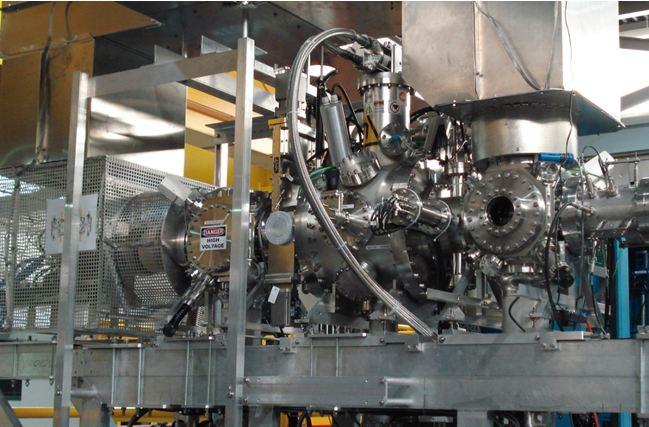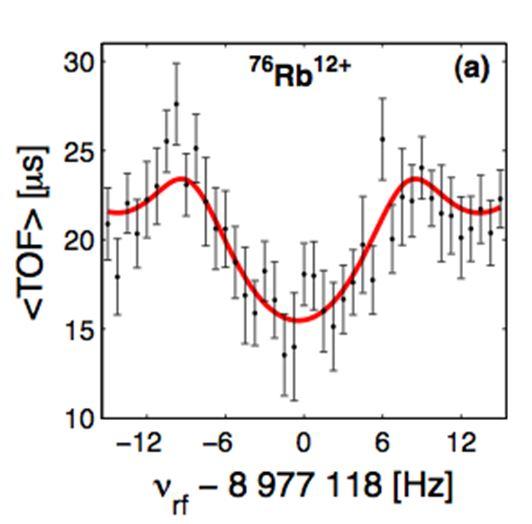Mass measurements of radioisotopes become even more precise
Ernest Rutherford, sometimes called the father of nuclear physics, once said that "If your experiment needs statistics, you ought to have done a better experiment." This advice was taken as valuable inspiration by the TITAN group; the team recently introduced a novel method which opens the door for unprecedented precision in mass measurements of radioactive nuclides. The TITAN group recently exploited this technique to measure the mass of the short-lived nuclide rubidium-74 (Rb-74). This nuclide is important for the study of the weak force in beta decays of atomic nuclei. However, due to its short half-life of only 65 ms previously posed a real challenge to experiment.
Studies of nuclear beta decays have a long and insightful tradition in the research of the weak force. It ranges all the way back to the postulation of the neutrino by Wolfgang Pauli in the 1930s to explain "missing" energy in beta decays. Today, phenomena of the weak force are well described as part of the Standard Model of particle physics. Despite its overwhelming success, physicists expect the Standard Model to be incomplete. Hitherto unknown physics might appear just around the corner. One approach to spot new physics is to measure observables of well-understood processes with high precision. Even tiny deviation from the expectation of the Standard Model could point to new physics operating at or above energies which would otherwise only be accessible at high energy particle accelerators, like the LHC at CERN.
Research programs focusing on so-called superallowed nuclear beta decays fall into this category. Due to the simplicity of these decays, difficulties in the understanding of the internal structure of nuclei are greatly reduced which normally limit the implications of precision experiments of nuclear beta decays. Hence, superallowed beta deacys are of particular interest in the search for exotic interactions in the weak force.
Precise knowledge of masses of a superallowed beta emitter and its decay daughter is critical in this research, because according to Einstein's famous E=mc2 their mass difference equals to the transition energy of the decay. To date, mass measurements performed in Penning traps yield the highest precision, even for short-lived radioactive nuclides. In a Penning trap, ions are confined by a combination of a magnetic and an electric field. By measuring the cyclotron frequency (i.e., the "spinning frequency") of a trapped ion in the magnetic field the ion's mass is determined. Rb-74 is the heaviest, well studied superallowed beta emitter, and has already been investigated three times in Penning traps. Nevertheless, the uncertainty in its mass is still significantly larger than desired. This is a consequence of the very short half-life of Rb-74 and points to the limitation of conventional Penning trap mass spectrometry.
| Now, the TITAN group has for the first time introduced highly charged ions of radioactive nuclides to this type of measurements. As a result, the experimental precision is boosted by a factor identical to the charge state q of the ions. The highly charges ions are attained by injecting singly charged, radioactive ions delivered by TRIUMF's ISAC facility into an electron beam ion trap (EBIT). Electrons of the EBIT's intense electron beam "knock-out" bound electrons. Hence, the ion is brought into the higher charge state. Because of the short half-life and constraints in the production yield of radioisotopes, the charge breeding is challenging; it needs to be fast and efficient. By mass measurements of several Rb-isotopes including Rb-74 in charge states of q=8-12+ (hence with 8 to 12 electrons removed) the TITAN team has demonstrated that despite these difficulties this path towards unrivaled precision is indeed feasible. |  |
| Photograph of the EBIT device. | |
| The present result for Rb-74 is important by itself and confirms---in a significantly reduced measurement time---the three previous Penning trap mass measurements combined. It was published in Physical Review Letters and selected as an Editors' Suggestion. However, the TITAN team sees these first successful mass measurements of highly charged, short lived radionuclides in a Penning trap rather as the beginning of their work on the precision frontier. A more intense electron beam for instance could reach an even higher charge state in a shorter amount of time. The present measurements used an electron beam of "only" 10 mA while TITAN's EBIT is capable of up to 500 mA, and can be upgraded by another factor of 10. Further news from TITAN regarding additional gains in precision can be expected. |  |
| A measurement of the cyclotron frequency of radioactive Rb-76 in charge state Q=12+. |
In the realm of weak interaction studies in low-energy nuclear systems such as in Rb-74, the precision opened by highly-charged ions is essential. For mass measurements motivated by nuclear structure or nuclear astrophysics, the present experimental precision is already sufficient. Here, this novel technique significantly reduces the measurement time and thus allows one to map the nuclear-mass landscape more broadly. This is of particular importance when ARIEL, TRIUMF's next-generation isotope facility, will come online and a wide range of previously inaccessible nuclides will be in experimental reach. In the exploration towards the limits of nuclear existence where experimental efforts typically face shorter half-lives and lower production yields of radioisotopes, the same precision can be achieved by compensating for both challenges with the higher charge state.
In the past when still working with single charged ions, the TITAN team used to explain the achieved, relative precision as if one measured the mass of a loaded jumbo jet airplane and was able to detect the mass difference to checked whether a person had forgotten his or her passport. These days, when utilizing highly charged ions, the sensitivity is increased to observe the mass difference when a single page is missing from the passport.
Further details: http://prl.aps.org/abstract/PRL/v107/i27/e272501.
-- by Stephan Ettenauer, UBC and TRIUMF
